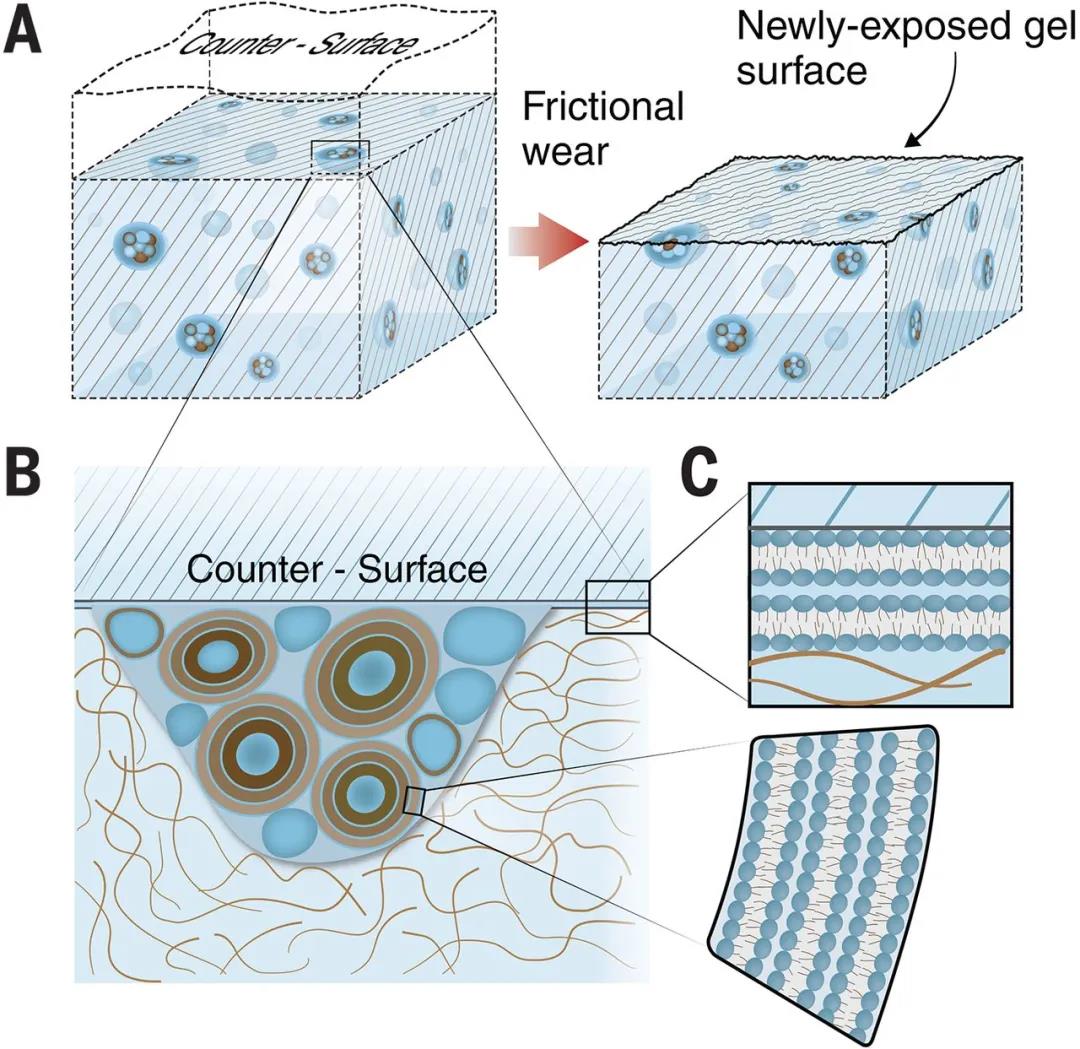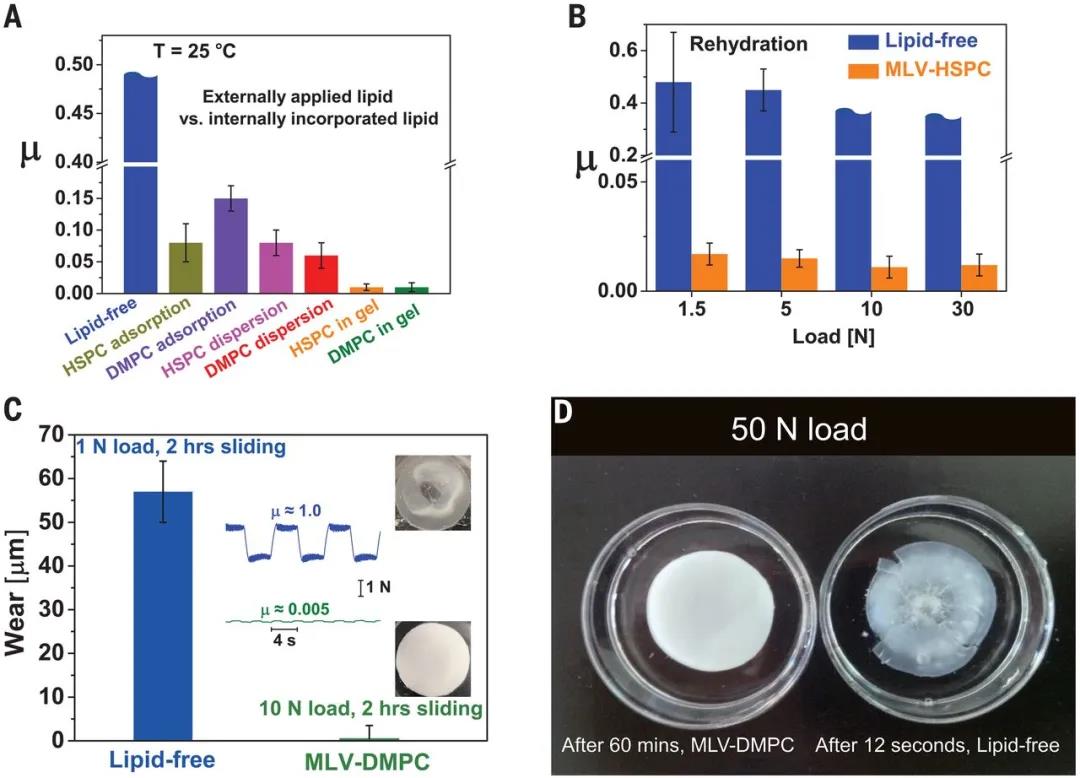
hotline:
17715390137
Tel/Wechat:
18101240246 (Technology)
0512-68565571
Email:mxenes@163.com (Sales Engineer)bkxc.bonnie@gmail.com
Scan the code to follow or search the official account on WeChat:
2D Materials Fronrier After paying attention,
click on the lower right corner to contact us,
Enter enterprise WeChat.
Professional Services Online

Hydrogels are a network of hydrophilic polymer chains that can absorb large amounts of water or biological fluids. In many biomedical and other applications, whenever surfaces slide over each other, their lubricity is extra important to their effective function. At present, the lubricity of the hydrogel surface mainly depends on the smooth interface formed by the liquid retained on the gel. However, the lubricity of this type of hydrogel will not continue to be lubricated during the entire use process (especially under load).
We know that every part of our body is an excellent biological material. By imitating their composition, it is very helpful for the design of artificial biological materials. In response to the above-mentioned problems, think about which part of our body has experienced the entire life cycle and rarely appears unlubricated?
Yes, that is articular cartilage!
The low friction of articular cartilage is due to the fluid pressure supporting most of the load, while its boundary lubrication is due to the non-fluid boundary layer on its surface. Studies have found that after the boundary layer is worn, it mainly relies on cell replenishment and self-assembly of its components (including hyaluronic acid, grease, PC lipid) for supplementary lubrication. These components are ubiquitous in cartilage and surrounding synovial fluid, so it is easy to use as a lubricating layer to keep on the joint surface. Among them, PC lipids are especially among these components, which can reduce the friction of the sliding surface through the hydrated phosphorylcholine head group.
So, can the surface friction of the hydrogel be reduced by adding these components to the hydrogel?
New strategy
In view of this, Jacob Klein and Ronit Goldberg of the Weizmann Institute of Science in Israel used low-concentration lipids to simulate and modify various synthetic hydrogels to create a lipid-based, self Newer and molecularly thin boundary layer. Experimental results show that the friction (and wear) of this material is significantly reduced by nearly 100 times compared with lipid-free hydrogels. Moreover, even if the gel is dried and rehydrated, it still maintains a good effect. The results were published in the Science journal.

Figure 1. A lipid-based boundary lubricant hydrogel inspired by cartilage
Reduce friction on the surface of multiple materials
Biotribology is the study of lubrication, friction and wear corresponding to biological systems or natural phenomena. The coefficient of friction is a system variable that depends on the test variable, surface and geometry. Considering this dependence, Lin et al. provided exact data, demonstrating their reliable and effective lipid-based boundary lubrication in hydrogels. They tested many different hydrogels, including biopolymers and synthetic polymers, and showed that lipid incorporation effectively reduces friction. They also tested different opposing surfaces other than steel and again found that the friction was effectively reduced. Finally, they examined various sliding speeds, and the almost constant coefficient of friction provided evidence that boundary mode lubrication was effective.

Figure 3. Sliding between a steel ball and pHEMA hydrogel
Want to update yourself? Just rub it
The final results highlight the importance of incorporating lipids into hydrogels to provide self-renewing boundary lubrication. The author further proved that sliding is the key driving force for the formation of a lipid layer on the surface of the hydrogel, and to realize the self-renewal of the lubricating layer, the hydrogel needs to be frictionally worn. In addition, compared with the incorporation of lipids into the hydrogel, the lubrication effect of simply adding lipids externally (such as soaking) for lubrication is much worse. Because it is difficult for lipids in the external solution to enter the gel/reverse surface interface. Likewise, the incorporation of lipids does not change the mechanical properties of the hydrogel, which may be relevant in various applications.
In addition, the concentration of incorporated lipids can be changed, which allows adjustment of the lubricity and duration of the hydrogel. The key factor regarding the potential use of these hydrogels is that these hydrogels must wear out in a self-renewing manner. Although the author proves that this kind of wear is small and the material can withstand many cycles, this parameter may affect the service life and needs to be considered for different applications.
Rehydrate after drying and still maintain lubrication
Finally, a surprising function of these hydrogels may open the door to many applications, even after being completely dried to 60°C in an oven and rehydrated, they can still maintain their own lubricity. In fact, this sturdy performance has a huge impact on the storage of hydrogels, and may have an impact on their practicality under harsh conditions, which is impossible for many other materials.

Figure 4. Friction and wear of lipid-treated pHEMA gel
Future application
Lin et al. have demonstrated a simple and effective method of producing self-lubricating hydrogels by incorporating lipids with minimal impact on overall mechanical properties. These materials can be used in biomedical applications where continuous and extreme friction and wear may occur, as well as various applications in tissue engineering, biosensors and even contact lenses. Considering that hyaluronic acid and lubricating elements were initially studied as simple lubricants, but in the end more research on their biological properties was carried out, so these hydrogels can play more complex functions besides pure lubrication. Biological functions, such as drug delivery devices, anti-inflammatory drugs or immune response modifiers. Indeed, this discovery has potential applications in many fields related to biology and medicine, and there is hope to see the direction of future research and applications.
references:
1. Weifeng Lin et al. Cartilage-inspired, lipid-based boundary-lubricated hydrogels. Science, 2020, 370, 6514, 335-338.
DOI: 10.1126/science.aay8276
https://science.sciencemag.org/content/370/6514/335
2. Tannin A. Schmidt. Lubricating lipids in hydrogels. Science, 2020, 370, 6514, 288-289.
DOI: 10.1126/science.abd3831
https://science.sciencemag.org/content/370/6514/288
Article source: On the Wonders
This information comes from the Internet for academic exchange only. If there is any infringement, please contact us to delete it immediately.

| Reminder: Beijing Beike New Material Technology Co., Ltd. supplies products only for scientific research, not for humans |
| All rights reserved © 2019 beijing beike new material Technology Co., Ltd 京ICP备16054715-2号 |